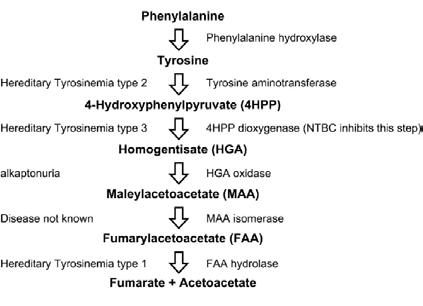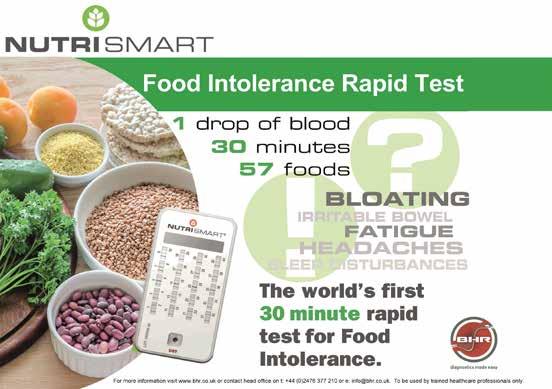
27 minute read
IMD watch
Suzanne Ford Dietitian in Metabolic Diseases
Sarah Howe Specialist Dietitian
Advertisement
For full article references please email info@ networkhealth group.co.uk
Suzanne Ford works as a Metabolic Dietitian for Adults at North Bristol NHS Trust. She has been a Dietitian for 21 years, with six of them working in Metabolic Disease.
Sarah is a Specialist Dietitian working with adults with inherited metabolic disorders, with PKU being her biggest cohort of patients.
TYROSINAEMIA TYPE I AND II
Tyrosinaemias are a group of inborn errors of metabolism and for optimum adult functioning and outcome, lifelong treatment is needed1 with a low protein diet, amino acid supplements and regular monitoring of nutritional status.
Tyrosine is a conditionally essential amino acid derived from dietary protein intake and the hydroxylation of phenylalanine. Tyrosine is either incorporated into proteins in the body, or it is degraded into fumarate (Krebs Cycle compound) and acetoacetate (ketone body). There is a five-step process to this2 which happens in liver cells and also the kidneys (Figure 1).
Tyrosinaemia Type I:
• Worldwide incidence of about 1 in 100,000 with a higher incidence in
Norway and Canada and specifically in a region of Quebec where the frequency is as high as 1 in 700.2 • Originally the most severe type with high child mortality rate unless liver transplants were performed. • Also known as hepatorenal tyrosinaemia. • Results from a defective enzyme fumarylacetoacetate hydrolase (FAH). • The toxic metabolite which accumulates and causes damage in liver and kidneys is succinylacetone. • Tyrosine levels are typically only moderately raised, at around 250-500umol/l in untreated disease.3 • Drug treatment with Nitisinone (NBTC) has greatly improved outcomes4 by effectively suppressing production of succinylacetone, although there is also an increase in serum tyrosine, making dietary treatment also an essential treatment.5 • Low protein diet with tyrosine and pheny-lalanine free amino acid supplements needed.
Figure 1: Catabolic pathway for phenylalanine and tyrosine
OUR PRODUCTS AND SERVICES ARE HERE TO SUPPORT YOUR PATIENTS AT EVERY STEP
Convenient and resealable so you can take it anywhere. Comes in a 125ml (20g PE) pouch.

Contains DHA, an omega-3 fatty acid which contributes to the maintenance of normal vision and brain function, along with additional vitamin D which can help with the maintenance of bones.
Lowest calorie ready-to-drink option available for patients with TYR with just 120kcal per 20g PE pouch.
Lowest volume ready-to-drink option available for patients with TYR. Just 3 x 125ml packs provide 60g Protein Equivalent (PE).
TYR Lophlex LQ Juicy Berries contains natural fruit juices from concentrate for a refreshing taste experience.
TYR ANAMIX INFANT
0-12 MONTHS
•Contains DHA and fibre. TYR ANAMIX JUNIOR POWDER
1-10 YEARS
•Contains DHA to support normal vision and brain function. •Contains calcium, vitamin D and fibre. TYR ANAMIX JUNIOR LQ
1-10 YEARS
•Convenient, ready to drink; perfect for lunch boxes. •Contains DHA, calcium and vitamin D.
For more information about the Nutricia product range, please contact your Nutricia Metabolic Representative, or call 01225 751098.
Cohort Recommended tyrosine (μmol/l) Recommended Phenylalanine (μmol/l)
Unaffected Adult Tyr Type I Tyr Type II 30-1206
200-4005
200-5001
>406,8
>501
Tyrosinaemia Type II:
• Incidence of about 1 in 250,000 • Also known as oculocutaneous tyrosinaemia or Richner-Hanhart syndrome. • Less severe than Type I although there is no drug treatment available. • Results from a defect in the enzyme tyrosine aminotransferase (TAT). • Tyrosine levels are typically >1,200umol/L.6 • The symptoms develop from an accumulation of tyrosine itself, crystallizing in the cornea and skin. • Neurological development can be affected with the potential for poor intellectual attainment.7 • Low protein diet, with phenylalanine- and tyrosine-free amino acid supplements needed
METABOLIC AND NUTRITIONAL GOALS OF TREATMENT The aims of treatment are to achieve blood tyrosine levels within the ranges shown in Table 1, whilst optimising nutritional status.
WHAT ARE THE COMPONENTS OF THE DIET?
Protein substitutes
A phenylalanine- and tyrosine-free amino acid supplement is important to avoid protein deficiency and prevent muscle catabolism. There is a small range of products available in ready-to-drink form and in powders which can be flavoured. The supplements should be taken throughout the day to optimise metabolic control, achieving the most stable blood tyrosine levels.
Amino acid consumption is reported by people with IMD as the most difficult aspect of the diet.9 Amino acids are bitter and acidic tasting; they can cause gastrointestinal symptoms and bad breath and the prescribed amount is usually a significant volume: 400mls/ day in adults if taking a ready-to-drink version. The amount or volume of amino acids prescribed needs to account for inefficiencies in amino acid and protein metabolism and as much as 140% of the RNI for protein may be needed in total.6
Micronutrients are needed as per the relevant dietary reference values (reference nutrient intake) for age, gender and life stage. A highly restricted protein intake results in low intakes of vitamin B12, long chain polyunsaturated fatty acids (LCPUFAs) and essential fatty acids, as well as minerals such as iron, calcium and zinc. Micronutrients are present in the protein substitute products, although LCPUFAs may not be, making compliance with these products even more important.
Low protein foods
Naturally occurring low protein foods, such as fruit and vegetables and fats and sugars, should form the bulk of the diet. Low protein foods which are available on prescription (e.g. milk substitute, flour, bread, pasta, crackers and biscuits) are a good way to make the diet palatable, varied and energy balanced. Consistent energy intake is important, as catabolism could cause muscle breakdown and raise blood tyrosine levels.
Protein exchanges
People with tyrosinaemia need to restrict high protein foods (meat, fish, eggs, cheese, nuts, beans, soya and dairy) and follow a tailored diet with a specific number of protein exchanges.
One exchange = 1g protein, or an assumed 50mg tyrosine.
Natural protein, (i.e. phenylalanine and tyrosine) tolerance varies with age, severity of the disorder and size of the individual, as well as their life stage, gender and general health.
A certain amount of both tyrosine and phenylalanine will be needed to keep blood concentrations within range and prevent muscle breakdown. The balance between natural protein and
Food
Cows’ milk Single cream Double cream Yoghurt
Rice - boiled
Rice - raw
Amount for 1 exchange Food
Amount for 1 exchange
30mL Jacket or boiled potatoes 50g 30mL Roast potatoes 60mL Chips 35g 25g
20g Broad beans 45g Peas (fresh, frozen and tinned) 15g Spring greens (boiled) 12g
15g
55g
amino acids to meet overall nitrogen requirements is individualised and also may need adjustments over time to allow for growth, development and changes in health status, such as pregnancy.
MONITORING Monitoring is encouraged to ensure both metabolic and nutritional goals are met. Home-based monitoring and clinic monitoring is done, thus people with tyrosinaemia may need encouragement to comply with treatment and testing.
Monitoring in adults with tyrosinaemia includes the following: • Monthly dried blood spots for plasma tyrosine and phenylalanine. • Annual or twice yearly nutritional bloods in clinic: - Plasma Amino Acid profile - Full blood count including haematocrit - Haematinics including serum ferritin, serum folate and serum B12 - Adjusted calcium and, if available, zinc, selenium and copper
The nutritional deficiencies which are possible in IMDs are wide ranging and are more likely if someone follows a low protein diet, but is poorly compliant with their protein substitute. The nutritional deficiencies which may arise include protein deficiency, as well as vitamin, mineral and trace element deficiencies, such as anaemia and poor bone mineral density.
PHENYLALANINE SUPPLEMENTATION On routine blood monitoring, patients with both Type I (NBTC treated) and Type II tyrosinaemia have been found to have low blood phenylalanine concentrations and needed supplementation.10 Phenylalanine is an essential amino acid and deficiency can cause anorexia, skin rashes and, in the longer term, changes to skin and nails, lethargy, mental retardation, seizures and death. Phenylalanine monitoring is an essential part of treatment. If phenylalanine intake is insufficient then this amino acid will be rate limiting in bodily protein synthesis, potentially causing catabolism and thus raising tyrosine levels.
Recently published data from a group of children with Type I tyrosinaemia11 suggests that morning blood phenylalanine levels are very different to afternoons; only 2% of fasting morning levels were under the treatment range, but in the same children 83% of non-fasting afternoon blood samples were below target range. Thus the timing of biochemical monitoring must be considered when interpreting data and making decisions about dietary control. The main concern raised is that, potentially, children or adults with tyrosinaemia may have periods of the day when phenylalanine levels are too low and this compromises growth, development or neurocognitive functioning. (The tyrosine levels were stable through morning and afternoon). The threshold to supplement with additional phenylalanine may need to be considered at a higher level in light of these findings.
TREATING POOR METABOLIC CONTROL Raised tyrosine levels, due to low phenylalanine levels, can be addressed by supplementing with phenylalanine. However, increased tyrosine levels due to inadequate energy intake are usually addressed by increasing calories, specifically with carbohydrates, such as a sugary or glucose polymer drink. Raised tyrosine levels in the absence of catabolism may be addressed by reducing protein exchanges, but in all of the above scenarios, attention should also be given to compliance with taking the tyrosine and phenylalanine-free protein substitute.
PREGNANCY IN TYROSINAEMIA There has been a small number of encouraging reports of successful pregnancies in tyrosinaemia and these include pregnancy whilst taking NTBC. In Type II tyrosinaemia in particular, blood tyrosine control needed to be stricter than usual for a successful outcome (100-200umol/L).1 In practice, this means returning to a strict exchange system for counting natural protein and decreasing the number of permitted protein exchanges for the first and possibly second trimester.
By mid-gestation, the foetus needs more protein for growth and protein tolerance, and permitted protein exchanges may be more than double the original number at the start of pregnancy. Protein tolerance continues to increase throughout the third trimester.
Untreated tyrosinaemia in pregnancy can, but not always, result in poor outcomes12 for the offspring.
Pregnancy and post-delivery triggers for metabolic imbalance include: • the first trimester when energy intake may be difficult to maintain (if there is morning sickness); • post-partum (involution of the uterus and a large release of endogenous protein); • breastfeeding which imposes metabolic demands - however breastfeeding is strongly encouraged for people (mothers and babies) with metabolic disorders.
CASE STUDY - JANE: TYPE II TYROSINAEMIA
Jane has Type II tyrosinaemia which was diagnosed at age 7. She previously had a gastrostomy tube inserted for receiving her amino acid supplement. She is 32 years old, married, without children and works as a care assistant. Jane’s medical history includes epilepsy, a cataract, dietary zinc deficiency, osteopaenia, low mood, miscarriages and, this year, she suffered from a fractured wrist.
Jane’s diet
• Low protein diet (about 15-20g/day, she doesn’t accurately count exchanges) • Prescribed three times daily protein substitute - with poor compliance • Tyrosine levels are rarely <700umol/L and often>1,000umol/L
Issues
• Jane moved house and changed GP which resulted in an incorrect prescription for her protein substitute and non-compliance for 12 months. • There was an 18-month loss of contact with the patient by her metabolic clinic. • Jane’s diet became nutritionally inadequate since she was still following a low protein diet without taking her protein substitute. • Jane’s eyes became intermittently itchy, but it did prompt her to seek help from her GP.
The role of the dietitian
The role of the dietitian is collaboration with the patient to motivate and provide practical ways to follow the diet for tyrosinaemia. Another significant role is to ensure that all healthcare providers, especially prescribers, completely understand the disease, the treatment and the products involved.
Outcome for Jane
Jane is trying to increase her intake of her protein substitute and manages the full prescribed amount on working days, but less so on weekend days. She continues with her low protein diet. Jane’s nutritional monitoring has increased in frequency, including monitoring of her bone health.
Conclusion
Tyrosinaemia Types I and II are conditions with low incidence; however, people with these conditions need careful consideration in their dietetic treatment. The evidence base is small for these conditions, but it is clear that for good outcomes, compliance with diet and monitoring is vital. For best functioning in adults, lifelong dietary treatment is needed.
Helen Willis BSc RD apetito and Wiltshire Farm Foods Dietitian
Helen Willis is a member of the British Dietetic Association and National Association of Care Catering. She previously worked in the NHS in both acute and community dietetics.

DYSPHAGIA: THE HARD TO SWALLOW TRUTH
Education, awareness and team work combine to help improve the quality of life for those suffering with dysphagia.
Imagine being afraid to eat a meal because you know you could choke on it, or adversely not wanting to eat at all because the ingredients have been pulverised to such an extent that they are devoid of any taste or flavour. This is the daily reality for millions of people all over the world who suffer from dysphagia, a secondary condition that makes it hard and sometimes impossible to swallow food and liquids.
Dysphagia is estimated to affect approximately 8% of the world’s population - just under 100 million people. This figure is predicted to significantly increase over the next few years in line with an ageing population and, although a significant proportion of sufferers are elderly, it can impact people of all ages. Dysphagia often manifests in stroke survivors, those with multiple sclerosis, children with Acute Cerebral Palsy and those with dementia.
It is not a condition that is always readily monitored or diagnosed in the UK. An assessment by a Speech and Language Therapist (SLT) is needed to make an accurate diagnosis. However, the Royal College of Speech and Language Therapists estimates there are 2.5 million people in the UK needing the help of its members, but there are only 14,000 qualified SLTs practicing in England.
The issue posed by lack of diagnosis means that patients are not always getting the help they need or the nutritionally-balanced meals that they can easily swallow, either in a healthcare setting or at home. Research also indicates that those working in the healthcare sector do not regularly ask patients about swallowing difficulties, which compounds this issue. Add to this a worrying lack of easily accessible information, not only for those living with the condition, but also for those who are advising and caring for them.
The solution to preparing meals for someone with dysphagia is often deemed to be blending ingredients together to make them easier to swallow. Textures are then adjusted by adding water or other liquids to achieve a desired consistency. As dietitians and nutritionists know, this approach can impact on the flavour of the food and can result in patients not eating at all. This can then lead to further issues for the most nutritionally vulnerable.
When questioned, over half of those working in healthcare said that their knowledge felt out of date on the current nutritional treatment approach for dysphagia. This indicates that education is key. Everyone deserves to dine with dignity and enjoy their food. But, it is clear that there is not enough information freely available via the NHS and other channels, as well as not enough education and training for those working with dysphagia patients on a daily basis. Action needs to be taken now to support healthcare professionals, allowing them to access specialised help and work together as a team in the best interests of the patient.
‘The Knowledge: Dysphagia - The Hard to Swallow Truth’ is the first in a series of white papers by apetito exploring some of the key health and nutrition challenges facing the health and social care sector. Download the report can be downloaded from www.apetito.co.uk
NETWORK HEALTH DIGEST
DYSPHAGIA PRODUCTS CURRENTLY AVAILABLE (SEPT 2016)
STARCH BASED THICKENERS
Product Manufacturer Thickener ingredients Cost per tub Quantity of thickener required per month to thicken 1600ml fluid per day to stage 1 (kg) Prescription cost per month of thickening 1600ml fluid per day to stage 1
(prepared according to manufacturer’s instructions)*
Multi-Thick
Nutilis Powder
Resource ThickenUp Abbott (approx. figures required for 30 days)
Nutricia (approx. figures required for 28 days)
Nestlé Health Science Modified maize starch £4.83/250g 1.296-2.592 £25.04-£50.08
Modified maize starch, Tara gum, Xanthan gum, Guar gum £5.01/300g 1.792-2.688 £29.93-£44.89
Modified maize starch £4.66/227g 2.016 £41.39
Thick & EasyTM Fresenius Kabi Modified maize starch £5.12/225g 2.016 £45.88
Thicken Aid M & A Pharmachem Modified maize starch, Maltodextrin £3.71/225g 2.016 £33.24
Thixo-D Original Sutherland Modified maize starch £5.79/375g 2.24 £34.59
Vitaquick Vitaflo Modified maize starch £7.05/300g 1.500 £35.25
GUM BASED THICKENERS
Nutilis Clear Nutricia
Resource ThickenUp Clear Nestlé Health Science Dried glucose syrup, Xanthan gum, Guar gum £8.46/175g 0.672 £32.49
Xanthan gum, Maltodextrin £8.46/125g 0.537 £36.34
Thick & EasyTM Clear Fresenius Kabi Maltodextrin, Xanthan gum, Carageenan £8.80/126g 0.627 £43.79
Thixo-D CalFree Sutherland Xanthan gum £2.57/30g 0.280 £23.99
Product Manufacturer Consistency available Volume Nutritional content per serving
Resource Thickened Drinks Nestlé Health Science ‘Syrup’ ‘Custard’ 114ml cup 101-103 kcal (both textures)
Prescription cost per serving (and cost per month if 1600ml fluid provided per day)*
£0.73 (£286.88)
Slõ Drinks (water to be added) Slõ Drinks Stage 1 (cold/hot) Stage 2 (cold/hot) Stage 3 (cold)
THICKENED ONS - STAGES 1 AND 2
Product Manufacturer Consistency available Volume Nutritional content per serving Prescription cost per serving*
115ml cup (requires addition of water) 24-57 kcal 30-63 kcal 56-57 kcal £0.30 (£116.87)
Fresubin Thickened Fresenius Kabi Stage 1 Stage 2 200ml 300kcal 20g protein £2.31
Nutilis Complete Nutricia Stage 1 Stage 2 125ml 306kcal 12g protein £2.21
Slõ Milkshakes+ (water to be added) Slõ Stage 1 Stage 2 200ml 333.5kcal 24.2g protein £0.84 per sachet
ONS AND DESSERT-STYLE ONS (SUITABLE FOR STAGE 3 WHERE INDICATED)
Product Notes Manufacturer Volume Nutritional content per serving Prescription cost per serving*
Nutilis Fruit Stage 3
Ensure Plus Crème Guaranteed for stage 3 Nutricia 150g 200kcal 10.5g protein £2.36
Suitable for stage 3 under the advice of a HCP Abbott 125g 171kcal 7.1g protein £1.88
Forticreme Complete
Fresubin 2kcal Creme
Fresubin Yocreme
Nutricrem
Resource Dessert Energy Nutricia 125g 200kcal 11.9g protein £1.96
Fresenius Kabi 125g 250kcal 12.5g protein £1.93
Fresenius Kabi 125g 187kcal 9.3g protein £2.00
Nualtra 125g 225kcal 12.5g protein £1.40
Nestlé Health Science 125g 200kcal 6g protein £1.63
Victoria Williams Registered Dietitian, Betsi Cadwaladr University Health Board
Victoria has worked as a Dietitian for over 10 years and has worked in both acute and clinical community settings. She is currently specialising in Stroke and Diabetes.
DYSPHAGIA AND MOTOR NEURONE DISEASE: A CASE STUDY
Motor neurone disease (MND), or Amyotrophic lateral sclerosis (ALS), refers to a group of related disorders caused by the degeneration of the motor neurones in the brain and spinal cord.1,2 It affects up to 5,000 people in the UK at any one time.3 The symptoms of MND can be widespread with motor neurone degeneration causing weakness and wasting of muscles which can affect mobility, speech, swallow and respiratory function.4,5
There is currently no cure for MND, so care is focused on symptom management and palliation4 in order to maintain quality of life. A multidisciplinary approach is essential, as care of patients with MND is complex and relies on expertise from different disciplines to undertake assessment and co-ordinate appropriate care and treatment.5,8,2
Dysphagia associated with bulbar muscle involvement is common in MND5 and is present in 45% of patients at diagnosis, with 81% of all MND patients experiencing dysphagia irrespective of onset.2,6,8 It can affect all stages of swallowing due to weakness developing in the muscles involved, including the tongue, lips, facial muscles, pharynx and larynx7,8 (see Table 1). Swallowing disorders resulting in dysphagia are by far the most important cause of nutritional impairment.8
Table 1: Stages of swallowing8,9
Stage of swallow Characteristics in MND
Preparatory • Difficulty getting food/liquid into the mouth stage • Weak movement of lips, tongue & jaw affecting ingestion and bolus swallowing • Leakage of fluid on drinking due to poor lip seal Oral stage • Weak movement of lips, tongue and jaw • Poor mastication • Difficulty in forming a food bolus • Poor bolus manipulation • Weak bolus propulsion • Difficulty swallowing saliva
Pharyngeal stage • Delay initiating pharyngeal swallow • Pharynx residue post swallow • Decreased laryngeal elevation • Aspiration before, during and after swallow
Table 2: Weight and BMI
Consultations Weight (kg)
1 76
2 73.6
3 70.2
4 5 66.8 68.2
6 65
BMI (kg/m²)
24.3 23.6 22.5 21.4 20.4 20.8 20.3
CASE STUDY: 66-YEAR-OLD MALE DIAGNOSED WITH MND
Here I detail the nutritional management of a 66-year-old gentleman named Jim, who was assessed by a dietitian two months following diagnosis of MND. He was referred from the multidisciplinary MND team meeting.
Prior to initial assessment, I liaised with the Speech and Language Therapy (SLT) team to obtain details on recent swallow and communication assessments. At this point, he had no reported swallowing issues and was safe with normal diet and fluids. His main issues at this time was dysarthria. 1 Assessment Usual weight was reported to be 76kg which had remained stable for a number of years and body mass index (BMI) was within a normal range (Table 1, point 1). He was retired from employment, although he continued to maintain an active life through a house renovation project and was often working up to eight hours per day. He had no previous medical history and had recently been prescribed the medication Riluzole which can help to slow neurone damage.
Dietary intake was varied, balanced and sufficient to meet his estimated nutritional intake at this time. No concerns were reported with fluid intake which appeared to meet his requirements. No issues were reported with coughing or choking on foods.
The short-term dietetic aim was to maintain his current weight and nutritional status. Dietetic advice included a food-first approach with emphasis on the importance of maintaining dietary intake from energy dense meals, snacks and fluids. 2 Identification of nutrition and dietetic diagnosis As Jim had the bulbar form of MND knowledge of this led me to think about longer-term implications of dysphagia and how this would impact on his nutritional status. I therefore enquired regarding his knowledge of the condition and how much information they would like to receive. Although they had received some information from the neurologist and accessed the Motor Neurone Disease Association website, they wanted to know more about dysphagia and management options for the future. An explanation of this was provided in addition to looking into future options for nutritional support including gastrostomy placement.
Although I acknowledge that these are quite difficult conversations to have with patients and their relatives, it is important to address these issues and options early to ensure that individuals can have time to make an informed choice. The importance of discussing nutritional management options issues early is widely documented,1-10 however, I acknowledge that this approach may not be suitable for all patients who may be struggling to come to terms with their condition and decisions involved in planning for the future.10
Jim was reviewed three months later; weight had decreased by 2.4kg (3.2%) (Table 2, point 2) and I had received information from SLT outlining their current recommendations of level E diet and stage 1 thickened fluids from a recent swallow assessment.11 Dietetic assessment revealed that he was still eating and drinking well and appeared to be meeting dietary and fluid requirements despite advised changes to the texture of diet and fluids. No changes had been made to his activity levels and he continued to work for eight hours a day on his house. 3 Plan nutrition and dietetic intervention The short-term dietetic advice focused on appropriate food and fluid textures, in addition to reiterating methods of food fortification. Weight loss at the time was thought to be due to his daily activity and/or muscle wastage; however, subsequent literature has shown that 60% of patients with MND show a 10% increase of resting energy expenditure.8
The use of nutritional products was suggested to maximise energy and protein intake and Fresubin thickened stage 1 twice daily was initiated to provide an additional 600kcal and 40g protein per day with a short-term aim to arrest weight loss.
Jim and his wife had spent time thinking about our previous conversation and wanted to know more about the longer-term option of gastrostomy placement. A meeting was, therefore, set up with a Clinical Nutrition Nurse Specialist (CNNS).
Four weeks later, a joint consultation with a CNNS took place. Nutritional assessment revealed further weight loss (Table 2, point 3) and Jim had started to visibly notice the loss of muscle mass on his arms. He reported reduced strength and fatigue and had decreased work time to two hours per day. Difficulties with maintaining nutritional intake were reported, with Jim becoming tired in the evening causing him to take longer to complete his evening meal. He remained on a level E diet and stage 1 thickened fluid and was continuing to take oral nutritional supplements twice daily. Speech was becoming slow and labored and he was experiencing excessive salivation for which his GP had prescribed a hyoscine patch.
The short-term goal was to prevent further weight loss and strategies were suggested to enhance his intake when feeling less lethargic; this included changing his meal structure by having his larger meal earlier in the day and smaller meal in the evening. Dessert based nutritional products were trialed, but he wished to continue with Fresubin thickened stage 1 with an increase to 3 x 200ml daily (900kcal, 60g protein).
The CNNS discussed percutaneous endoscopic gastrostomy (PEG) tube and outlined the indications, procedure and possible complications. The risks versus benefits of the procedure were discussed12 and the implications of delaying the decision of PEG placement if respiratory function was to deteriorate, which is common in MND. Additionally, the options of continuing with oral intake versus gastrostomy were discussed alongside specific issues such as chest infections, reduced mobility and who would be responsible for the care of the tube. Jim expressed that he wanted to proceed with PEG placement and a planned admission was arranged.
Unfortunately, one week before the planned admission for PEG placement, Jim had an emergency admission to hospital with a myocardial infarction and respiratory issues. He was commenced on non-invasive ventilation (NIV). SLT carried out a swallow assessment on the ward and found that swallow had deteriorated markedly and advised a period of Nil by Mouth (NBM). 4 Implement nutrition and dietetic intervention To provide nutrition, consent was obtained to place a Nasogastric tube (NGT) and a 15-hour continuous feeding regime commenced. PEG placement was cancelled due to increased risks. However, after a twoweek admission, Jim was deemed safe to go home with his NGT in place. In preparation for this, the feeding regime was changed from a continuous method to bolus regime to fit in with his daily life and a nasal bridle was placed to reduce the risk of NGT displacement. Training was delivered by a CNNS to ensure that Jim and his wife were competent in administering feed and medications and a timetable was devised with the assistance of a pharmacist.
Prior to discharge, SLT had reviewed Jim’s swallowing and advised oral trials of 3 x 1/2 teaspoons of stage 2 thickened fluids no more than half hourly for comfort rather than rehabilitation of swallow. As this was insufficient to meet his nutritional requirements, full requirements were to be met via his NGT.
Speech had significantly deteriorated during his admission and SLT had provided an iPad to help with communication; however, he preferred the use of a pen and paper to express his needs.

Dysphagia is common amongst patients with MND . . . long-term methods of nutritional management need to be considered and discussed with patients, relatives and carers . . .
5 Monitor and review A domiciliary visit was carried out four weeks following discharge to review and assess nutritional status. Weight had continued to decrease (Table 2 point 4). Jim and his wife were administering 4 x 200ml bolus feeds per day which was providing approximately 1,600kcal, 68g protein and 2,000ml of fluid. No concerns were expressed with the management of administering bolus feeds and medications and this should have been sufficient to meet his current needs. During this period, there was no change to oral intake which remained as per SLT advice. He reported enjoying his oral trials for comfort and was taking Fresubin thickened stage 2 and thickened coffee. It was suggested that in view of weight loss, bolus feeds were to be increased to 5 x 200ml daily, providing 2,000kcal, 85g protein, 22,00ml fluid daily.
Following his recent hospital admission, the CNNS had liaised with members of the Nutrition Support team who arranged a planned admission for a radiologically inserted gastrostomy (RIG). This was deemed a more suitable option than PEG at this point due to recent respiratory issues and the need for NIV.
The RIG was placed with no issues and Jim resumed his usual bolus feeding regime. He felt his quality of life had improved and he no longer had the irritation from the NGT and no pressure of meeting his nutritional requirements orally. One month post-RIG placement, weight had increased (table 2, point 5) although swallow function dysphagia had deteriorated and he has been advised to remain nil by mouth due to frequent chest infections. He communicated that he was content with this as he had started to lose confidence with taking oral trials. 6 Evaluation In subsequent visits, no concerns were expressed regarding his bolus feeds or nutritional management, although Jim’s wife took over administering feeds when he started to lose strength in his hands. Weight decreased (Table 2, points 6 and 7) and symptoms of MND continued to progress rapidly post RIG placement and, unfortunately, he passed away eight months later.
Dysphagia is common amongst patients with MND and although short-term methods of nutritional support can be put into place to prevent deterioration in nutritional status, long-term methods of nutritional management need to be considered and discussed with patients, relatives and carers at a timely point to ensure nutritional status does not deteriorate.
For dietitians, it sometimes can be uncomfortable initiating conversations, but, irrespective of the decision made, early discussions allows individuals to make evidence-based informed choices.
References 1 Rio A and Cawadias E (2007). Nutritional Advice and treatment by dietitians to patients with amyotrophic lateral sclerosis/ motor neuron disease: a survey of current practice in England, Wales, Northern Ireland and Canada. Journal of Human Nutrition and Dietetics 20; 3-13 2 NICE (2016). Motor neuron disease: assessment and management www.nice.org.uk/guidance/ng42?unlid=7287371852016731143512 (accessed 05/08/16) 3 www.mndassociation.org/what-is-mnd/brief-guide-to-mnd/ (accessed 06/08/2016) 4 Daniel I, Greenwood BA (2013). Nutrition management of amyotrophic lateral sclerosis. Nutrition in Clinical Practice 28(3); 392-399 5 Kent A (2012). Motor neuron disease: an overview. Nursing Standard 26, 46, 48-57 6 Braun MM, Osecheck M, Joyce C (2012). Nutrition assessment and management in amyotrophic lateral sclerosis Physical Medicine Rehabilitation Clinics of
North America 23; 751-771 7 Stavroulakis T, Walsh T, Shaw PJ, Mcdermott CJ. On behalf of the PROGAS Study (2013). Gastrostomy use in motor neuron Disease (MND): A review, metaanalysis and survey of current practice. Amyotrophic lateral sclerosis and frontotemporal degeneration 14: 96-104 8 Muscaritoli M, Kushta I, Molfino A, Inghilleri M, Sabetelli M, Rossi Fanelli F (2012). Nutritional and metabolic support in patients with amyotrophic lateral sclerosis.
Nutrition 28: 959-966 9 Walshe M. Oropharyngeal Dysphagia in Neurodegenerative Disease. Journal of Gastroenterology and Hepatology Research 2014; 3(10): 1265-1271 10 Stavroulakis T, Baird WO, Baxter SK et al (2016). Factors influencing decision-making in relation to timing of gastrostomy insertion in patients with motor neuron disease. BMJ supportive and Palliative care. 6; 52-59 11 National Patient Safety Agency (2011). Dysphagia Diet Descriptors. Accessed online at: www.thenacc.co.uk/assets/downloads/170/Food%20Descriptors%20 for%20Industry%20Final%20-%20USE.pdf (06/08/16) 12 NICE (2006). Nutrition support for adults: oral nutrition support, enteral tube feeding and parenteral nutrition
Taking a step forward
with enteral nutrition DESIGNED TO BE BETTER TOLERATED BY CHILDREN WITH FEEDING DIFFICULTIES


The Peptamen® Junior range contains:
• 100% hydrolysed whey protein which may facilitate gastric emptying1-3 • High in MCTs to help minimise fat malabsorption4 • Low osmolarity to help improve GI tolerance • Peptides can be helpful to manage diarrhoea5,6 • Peptamen® Junior Advance - 1.5 kcal/ml for children with higher needs and/or on fluid restriction • Peptamen® Junior Powder - offering flexible caloric density (1-1.5 kcal/ml), helping your patients reach their calorific goals
For further information:
References: 1. Khoshoo V et al. J Ped Gastroent Nutr 1996; 22:48-55. 2. Fried MD et al. J Ped 1992; 120:569-572. 3. Khoshoo V et al. Eur J Clin Nutr 2002; 56:1-3. 4. Rolandelli RH et al. Lipids and Enteral Nutrition. In: Clinical Nutrition: Enteral and tube feeding. J.L. Rombeau, R.H. Rolandelli. W.B. Saunders Company, 1997. 5. McClave SA et al. JPEN 2009; 33:277-316. 6. Meredith JW et al. J Trauma 1990; 30:825-829.






